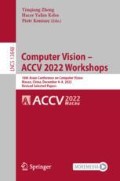Abstract
Deep Neural Networks (DNNs) have achieved great success in many applications, and they are taking over more and more systems in the real world. As a result, the security of DNN system has attracted great attention from the community. In typical scenes, the input images of DNN are collected through the camera. In this paper, we propose a new type of security threat, which attacks a DNN classifier by perturbing the optical path of the camera input through a specially designed filter. It involves many challenges to generate such a filter. First, the filter should be input-free. Second, the filter should be simple enough for manufacturing. We propose a framework to generate such filters, called ADVFilter. ADVFilter models the optical path perturbation by thin plate spline, and optimizes for the minimal distortion of the input images. ADVFilter can generate adversarial pattern for a specific class. This adversarial pattern is universal for the class, which means that it can mislead the DNN model on all input images of the class with high probability. We demonstrate our idea on MNIST dataset, and the results show that ADVFilter can achieve up to 90\(\%\) success rate with only 16 corresponding points. To the best of our knowledge, this is the first work to propose such security threat for DNN models.
Access this chapter
Tax calculation will be finalised at checkout
Purchases are for personal use only
References
Krizhevsky, A., Sutskever, I., Hinton, G.E.: ImageNet classification with deep convolutional neural networks. In: Advances in Neural Information Processing Systems 2012, pp. 1097–1105 (2012)
Wang, X., Li, J., Kuang, X., Tan, Y., Li, J.: The security of machine learning in an adversarial setting: a survey. J. Parallel Distrib. Comput. 130, 12–23 (2019). https://doi.org/10.1016/j.jpdc.2019.03.003
Szegedy, C., et al.: Intriguing properties of neural networks. Presented at the ICLR (2014). http://arxiv.org/abs/1312.6199. Accessed 22 Aug 2019
Goodfellow, I.J., Shlens, J., Szegedy, C.: Explaining and harnessing adversarial examples. Presented at the ICLR (2015). http://arxiv.org/abs/1412.6572. Accessed 22 Aug 2019
Chen, P.-Y., Zhang, H., Sharma, Y., Yi, J., Hsieh, C.-J.: ZOO: zeroth order optimization based black-box attacks to deep neural networks without training substitute models. In: Proceedings of the 10th ACM Workshop on Artificial Intelligence and Security (AISec), pp. 15–26 (2017). https://doi.org/10.1145/3128572.3140448
Ilyas, A., Engstrom, L., Athalye, A., Lin, J.: Black-box Adversarial Attacks with Limited Queries and Information (2018). http://arxiv.org/abs/1804.08598. Accessed 18 Aug 2019
Tu, C.-C., et al.: AutoZOOM: Autoencoder-Based Zeroth Order Optimization Method for Attacking Black-box Neural Networks (2019). http://arxiv.org/abs/1805.11770. Accessed 18 Aug 2019
Moosavi-Dezfooli, S.-M., Fawzi, A., Fawzi, O., Frossard, P.: Universal Adversarial Perturbations, p. 9 (2017)
Li, Y., Bai, S., Xie, C., Liao, Z., Shen, X., Yuille, A.: Regional homogeneity: towards learning transferable universal adversarial perturbations against defenses. In: Vedaldi, A., Bischof, H., Brox, T., Frahm, J.-M. (eds.) ECCV 2020. LNCS, vol. 12356, pp. 795–813. Springer, Cham (2020). https://doi.org/10.1007/978-3-030-58621-8_46
Zhang, C., Benz, P., Imtiaz, T., Kweon, I.S.: Understanding Adversarial Examples From the Mutual Influence of Images and Perturbations, p. 10 (2020)
Baluja, S., Fischer, I.: Learning to attack: adversarial transformation networks. In: The Thirty-Second AAAI Conference on Artificial Intelligence (AAAI) 2018, p. 9 (2018)
Li, M., Yang, Y., Wei, K., Yang, X., Huang, H.: Learning universal adversarial perturbation by adversarial example. In: Proceedings of the AAAI Conference on Artificial Intelligence, vol. 36, pp. 1350–1358 (2022). https://doi.org/10.1609/aaai.v36i2.20023
Engstrom, L., Tran, B., Tsipras, D., Schmidt, L., Madry, A.: Exploring the Landscape of Spatial Robustness (2019). http://arxiv.org/abs/1712.02779. Accessed 28 Apr 2022
Alaifari, R., Alberti, G.S., Gauksson, T.: ADef: an Iterative Algorithm to Construct Adversarial Deformations (2019). http://arxiv.org/abs/1804.07729. Accessed 28 Apr 2022
Xiao, C., Zhu, J.-Y., Li, B., He, W., Liu, M., Song, D.: Spatially Transformed Adversarial Examples (2018). http://arxiv.org/abs/1801.02612. Accessed 28 Apr 2022
Kurakin, A., Goodfellow, I., Bengio, S.: Adversarial examples in the physical world, arXiv:1607.02533 Cs Stat (2016). http://arxiv.org/abs/1607.02533. Accessed 22 Aug 2019
Sharif, M., Bhagavatula, S., Bauer, L., Reiter, M.K.: Accessorize to a crime: real and stealthy attacks on state-of-the-art face recognition. In: Proceedings of the 2016 ACM SIGSAC Conference on Computer and Communications Security - CCS 2016, Vienna, Austria, pp. 1528–1540 (2016)
Brown, T.B., Mané, D., Roy, A., Abadi, M., Gilmer, J.: Adversarial Patch, arXiv:1712.09665 Cs (2017). http://arxiv.org/abs/1712.09665. Accessed 22 Aug 2019
Athalye, A., Engstrom, L., Ilyas, A., Kwok, K.: Synthesizing Robust Adversarial Examples (2018). http://arxiv.org/abs/1707.07397. Accessed 28 July 2019
Athalye, A., Carlini, N., Wagner, D.: Obfuscated Gradients Give a False Sense of Security: Circumventing Defenses to Adversarial Examples (2018). http://arxiv.org/abs/1802.00420. Accessed 18 Aug 2019
Eykholt, K., et al.: Robust physical-world attacks on deep learning visual classification. In: IEEE/CVF Conference on Computer Vision and Pattern Recognition (CVPR), Salt Lake City, UT, USA, pp. 1625–1634 (2018). https://doi.org/10.1109/CVPR.2018.00175
Wang, D., et al.: FCA: learning a 3D full-coverage vehicle camouflage for multi-view physical adversarial attack. In: Proceedings of the AAAI Conference on Artificial Intelligence, vol. 36, pp. 2414–2422 (2022). https://doi.org/10.1609/aaai.v36i2.20141
Xu, K., et al.: Adversarial T-shirt! evading person detectors in a physical world. In: Vedaldi, A., Bischof, H., Brox, T., Frahm, J.-M. (eds.) ECCV 2020. LNCS, vol. 12350, pp. 665–681. Springer, Cham (2020). https://doi.org/10.1007/978-3-030-58558-7_39
Wierstra, D., Schaul, T., Peters, J., Schmidhuber, J.: Natural evolution strategies. J. Mach. Learn. Res. 15, 949–980 (2014). https://doi.org/10.1109/CEC.2008.4631255
Acknowledgements
We are particularly grateful to Inwan Yoo who implements TPS in Tensorflow and shares the code on https://github.com/iwyoo/tf_ThinPlateSpline.
Author information
Authors and Affiliations
Corresponding author
Editor information
Editors and Affiliations
Rights and permissions
Copyright information
© 2023 The Author(s), under exclusive license to Springer Nature Switzerland AG
About this paper
Cite this paper
Zhang, L., Wang, X. (2023). ADVFilter: Adversarial Example Generated by Perturbing Optical Path. In: Zheng, Y., Keleş, H.Y., Koniusz, P. (eds) Computer Vision – ACCV 2022 Workshops. ACCV 2022. Lecture Notes in Computer Science, vol 13848. Springer, Cham. https://doi.org/10.1007/978-3-031-27066-6_3
Download citation
DOI: https://doi.org/10.1007/978-3-031-27066-6_3
Published:
Publisher Name: Springer, Cham
Print ISBN: 978-3-031-27065-9
Online ISBN: 978-3-031-27066-6
eBook Packages: Computer ScienceComputer Science (R0)

